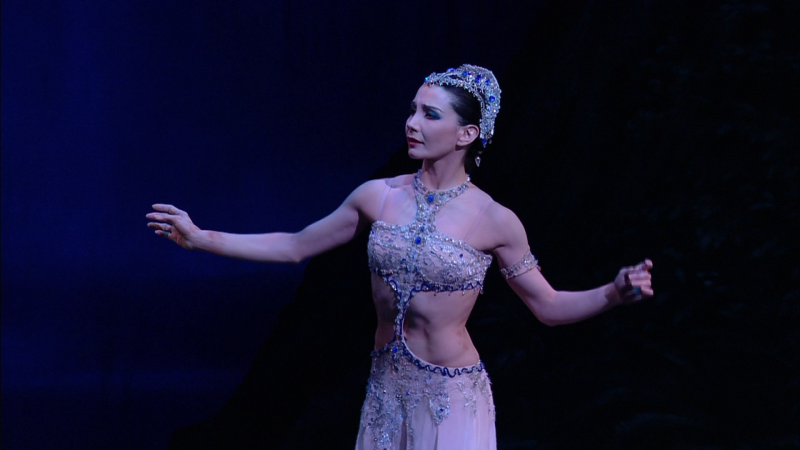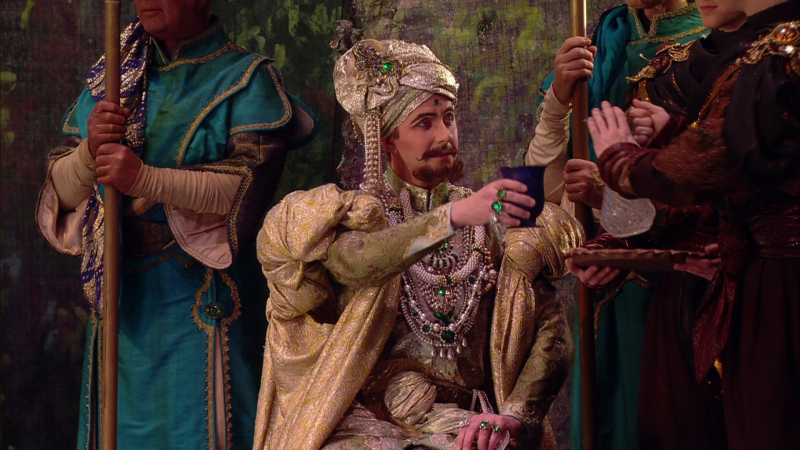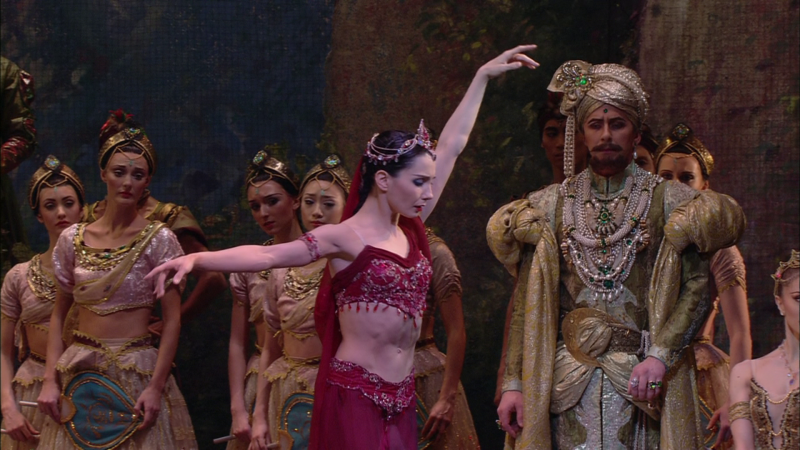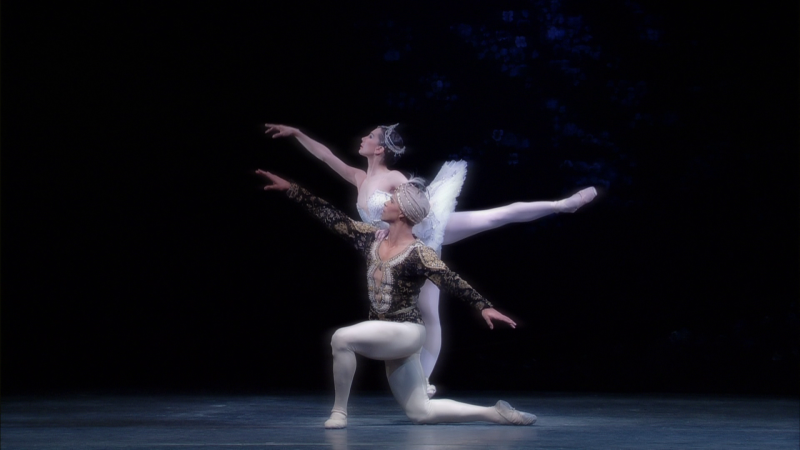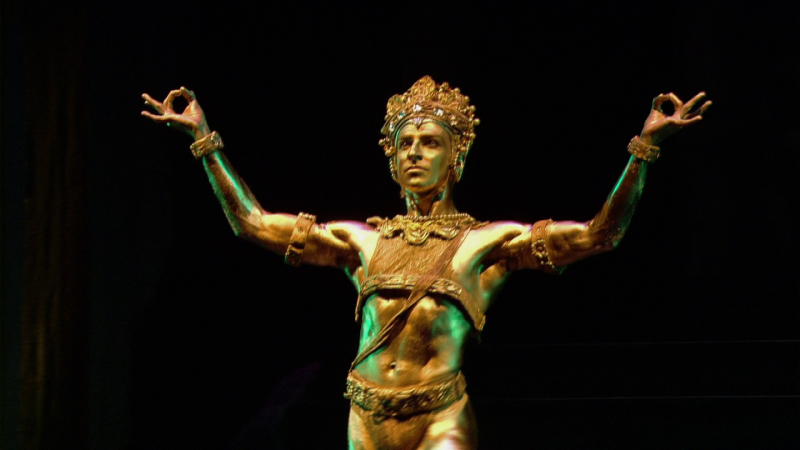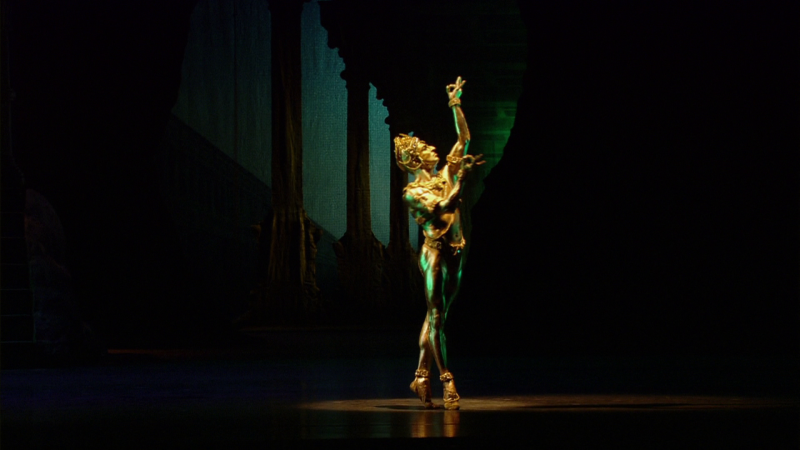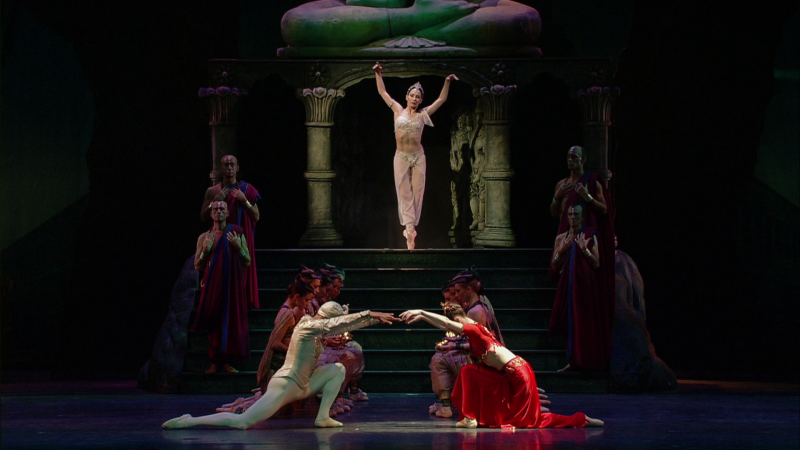
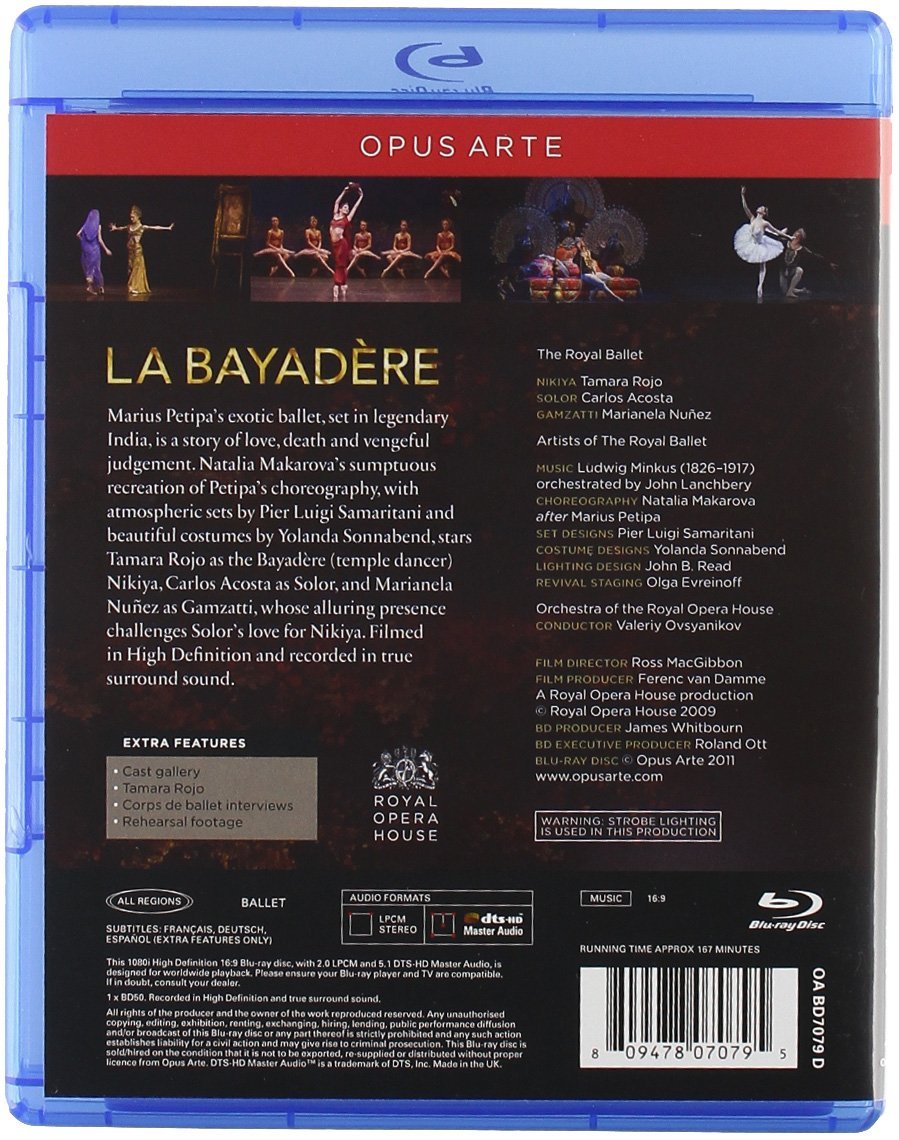
La Bayadère ballet. Music by Ludwig Minkus orchestrated by John Lanchbery. Choreographed by Natalia Makarova after Marius Petipa. Recorded 2009 at the Royal Opera House. Stars Tamara Rojo (The Bayadère, whose name is Nikiya), Carlos Acosta (Solor), Marianela Nuñez (Gamzatti, the Rajah's daughter) Gary Avis (The High Brahmin), Christopher Saunders (Rajah), Kenta Kura (Maghaveya, the Head Fakir), Genesia Rosato (Aya, Gamzatti's servant), Valeri Hristov (Solor's friend), and José Martin (The Bronze Idol). Tara-Brigitte Bhavnani, Francesca Filpi, and other artists of the Royal Ballet are the D'Jampe Dancers. Other dancers are Yuhui Choe, Iohna Loots, Emma Maguire, Samantha Raine, Helen Crawford, Nathalie Harrison, Hikaru Kobayashi, Laura McCullough, Johannes Stepanek, and Lauren Cuthbertson. Valeriy Ovsyanikov conducts the Orchestra of the Royal Opera House (concert masters are Peter Manning and Peter Schulmeister). Set designs by Pier Luigi Samaritani; costumes by Yolanda Sonnabend; lighting by John B. Read; revival staging by Olga Evreinoff. Directed for TV Ross MacGibbon; produced by Ferenc van Damme. Released 2011, disc has 5.1 dts-HD Master Audio sound. Grade: A
Sexy but also vulnerable-looking Tamara Rojo is perfect as the doomed temple dancer. She also provides a dramatic display of the anatomy of the ideal female midriff. Marianela Nuñez, so charming as the innocent teenager in Fille mal gardée, shows her acting range with a terrifying portrayal of Gamzatti, the Rajah's lustful, power-crazed daughter. The other credited dancers are fine, especially Carlos Acosta as Solor and José Martin as the Bronze Idol in a spectacular display of wonderful stagecraft and lighting.
The world created here probably bears the same relationship to ancient India that Superman bears to the science of law enforcement. But never mind: the sets and costumes are fantastic without being too gaudy or veering too deeply into kitsch. The music isn't great, but it is consistently engaging and well recorded; PQ is fine with a minimum of motion artifacts.
But there are a few soft spots. I praised Acosta already, but his character, Solor, the great warrior and hunter, is a complete wimp when faced with a sole voracious human female. There is a scrim that shows up from time to time, especially in close-up shots. And alas, the female corps of 24 is only adequate for the famous white scenes in Act 2. Once you have seen this done by the Paris Opera Ballet or the juggernaut Bolshoi Ballet with a female corps of 32, it's hard to be happy with anything less.
Now let's consider some screenshots; this ballet may not have the deepest psychological or artistic significance, but it's really fun to watch:
We start with the gorgeous Tamara Rojo as Nikiya, the lead temple dancer or Bayadére. Rojo has an huge intellect and resumé. She starred in 2 HDVD ballets from the Royal Opera House that we graded A+: the wonderful Romeo and Juliet (as Juliet) and in the McGregor Chroma. Rojo retired early from the ROH to be boss and principle dancer of the English National Ballet.
The High Brahmin priest (Gary Avis) is in love with Nikiya:
But Nikiya loves Solor (Carlos Acosta), who kills tigers with his spear:
Solor and Nikiya exchange promises:
But the Rajah (Christopher Saunders) wants Solor to marry his daughter, Gamzatti:
Gamzatti (Marianela Nuñez) is the kind of girl who usually gets what she wants:
In an effort to get rid of Solor, the High Brahmin tells the Rajah that Solor already belongs to Nikiya. But this plan backfires when the Rajah decides to solve his problem by just killing Nikiya. Gamzatti tries to solve the problem a different way: she lowers herself to offer a bribe to Nikiya if Nikiya will relinquish her claim to Solor:
But Nikiya spurns the bribe and fights back:
Humiliated, Gamzatti also vows to her wicked servant Aya (Genesia Rosato) that Nikiya shall be put down:
The Rajah offers Gamzatti to Solor. Overwhelmed by his desire for riches and status, Solor betrays Nikiya by accepting. There follows a lavish betrothal festival:
The High Brahmin orders Nikiya to dance at the festival. He hopes the dance will be enticing and that Solor's reaction to her dance will turn the Rajah against Solor. But Nikiya's dance is so expressive of sorrow and despair that it threatens to wreck the party. Alarmed, the Rajah orders Aya to fetch his murder weapon—a bowl of flowers to be given to Nikiya with a poisonous snake hidden under the blossoms:
An part of the ritual dance, the Bayadéde must smell the flowers and then strew the pedals across the floor in front of the couple to be wed:
The snake bites:
Poisoned, Nikiya sees her sweetheart leave the party with her nemesis:
The High Brahmin offers Nikiya an antidote to the venom; but Nikiya, having lost Solor, decides to die:
Solor recognizes his duplicity and cowardice. Crushed by remorse, he seeks refuge in opium:
In a drug-dream, Solor sees an army of spirits, dressed in white, mourning for Nikiya. This Kingdom of the Shades is the first of many Petipa abstract set pieces to come for the female corps in white, and these are today considered the zenith of the art of ballet. We are lucky to now have excellent HDVD productions of many of these ballets: Giselle, Sleeping Beauty, Nutcracker, Swan Lake, and Raymonda:
The largest ballet companies will have a white corps of 32; the ROB can only muster 24. The Bolshoi Ballet uses 4 ramps on the way down to the stage. The ROB, like most of the competition, has only a single ramp down to the stage:
And then the shade of Nikiya herself appears, granting Solor forgiveness and reconciliation:
The dream is shattered when Gamzatti enters the den and orders Solor to prepare for the wedding:
At the Temple, the Bronze Idol (José Martin) bounds to life. This is an unusual aspect of the ROB production. The Bronze Idol usually dances in Act 2 at big party for the engaged couple. But Natalia Makarova adds another scene (after the Kingdom of the Shades) with the wedding of Gamzatti and Solar. Makarova’s Bronze Idol performs as part of the wedding ceremony:
This makes a great PC wallpaper—try it!
The wedding ceremony begins:
But Nikiya haunts Solor's every step:
When Solor forces himself to utter his vow of marriage, an earthquake destroys the Temple and everyone inside:
Nikiya and Solor are finally united:
It’s now 2020 and we have 5 different versions of The Bayadère. All the others end with the conclusion of Solor’s vision of the Kingdom of the Shades—our hero is left alone is his misery. Makarova tacks on the “happy ending” above. Is this an improvement in the drama, or does it cheapen it?
Of the 5 Bayadères we now have, the Bolshoi and Paris Opera versions undertake to show the full splendor of Russian ballet with incomparable white formations of 32 dancers ending the show. The ROB is outclassed here, but their take may be more suitable for the new ballet fan or for family entertainment with its Makarova ending tacked on. If we ran the numbers on this to determine the quality of the video content, then this would probably have a case of DVDitis like most of MacGibbon’s other work with the ROB. This would then reduce the grade say to A- or B+. But out of admiration for the Rojo midriff and the great Bronze Idol PC wallpaper, I’ll leave the grade at A.
OR
